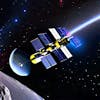S03E38: Mars Simulations & Electric Propulsion's Quantum Leap

Join host Anna on an enthralling expedition through the cosmos in today's episode of Astronomy Daily - The Podcast. We traverse the cutting-edge frontiers of space exploration, uncovering the innovative methods and ambitious missions that are shaping...
Join host Anna on an enthralling expedition through the cosmos in today's episode of Astronomy Daily - The Podcast. We traverse the cutting-edge frontiers of space exploration, uncovering the innovative methods and ambitious missions that are shaping our extraterrestrial aspirations. From simulating the Martian experience here on Earth to the potential of small spacecraft propelled by groundbreaking electric thrusters, this episode is brimming with interplanetary intrigue.
We begin with a look inside NASA's HERA, where four volunteers are immersed in a 45-day Mars habitat simulation at the Johnson Space Center. As they confront the challenges of isolation and confinement, their experiences offer vital insights into the psychological and physiological demands of deep space missions. With the support of international partners, this analog adventure is pivotal in preparing humanity for the red planet.
Next, we celebrate NASA's unveiling of the H71M Hall effect thruster, a propulsion marvel set to revolutionize the journey of small spacecraft to the moon, Mars, and beyond. This technological leap promises to expand our reach into the solar system, making interplanetary travel more accessible and cost-effective.
The conversation then shifts to China's Chang'e-6 mission, an ambitious lunar quest to retrieve samples from the enigmatic far side of the moon. As we anticipate the treasures it may uncover, we recognize the mission's potential to deepen our understanding of lunar geology and the history of our celestial neighborhood.
As the sun reaches its solar maximum, we explore the implications of heightened solar activity on Mars exploration. With the help of NASA's MAVEN orbiter and the Curiosity rover's RAD instrument, scientists are piecing together strategies to protect future astronauts from the sun's powerful outbursts, seeking answers to Mars's climatic transformation.
Lastly, we examine Nokia's pioneering efforts to establish a 4G LTE network on the moon. This lunar communication network, set to debut on an upcoming intuitive machines mission, could pave the way for robust, efficient communication systems supporting human and robotic operations on the lunar surface and beyond.
Prepare to be enlightened as we embark on this interstellar voyage through the latest developments in astronomy and space science. This is Astronomy Daily - The Podcast, where every episode is a step further into the infinite expanse of the universe.
---
**Featured Topics:**
1. **HERA's Mars Simulation:** A deep dive into NASA's analog mission to prepare for life on Mars.
2. **NASA's Hall Effect Thruster:** The propulsion breakthrough enhancing small spacecraft missions.
3. **Chang'e-6's Lunar Sample Return:** China's historic mission to the moon's far side.
4. **Solar Maximum and Mars Exploration:** Understanding solar activity's impact on future Mars missions.
5. **Nokia's Lunar Network:** The development of a groundbreaking communication system for the moon.
---
**Additional Information:**
For more cosmic content, visit astronomydaily.io, and join us on X (@AstroDailypod) for the latest updates and stellar discussions. Until next time, this is Anna, reminding you to keep your eyes on the skies and your sense of wonder alive. Clear skies and cosmic dreams to all our fellow stargazers!
This episode is brought to you by NordPass, the password manager that secures your celestial data. To grab our special offer and find out more, visit www.bitesz.com/nordpass
Become a supporter of this podcast:
AI Transcript
This podcast explores the latest developments in astronomy and space science
Anna: Welcome to Astronomy Daily, the podcast. My name is Anna, and I'm your host. In our celestial journey today, we'll delve into the groundbreaking strides pushing the bounds of space exploration and uncover the triumphs and challenges of space technology. We're discussing NASA's innovative use of earthbound simulations to prepare for life on Mars, unveiling a significant leap in electric propulsion that that might redefine the future of small spacecraft missions. We'll also navigate the pioneering efforts of China's Chang'e six mission, which seeks to retrieve precious samples from the moon's mysterious far side. As our solar sentinel mounts to its fiery peak, we'll learn how NASA scientists are gearing up for intense solar activity that could impact the future of human and robotic endeavors on Mars. And what about staying connected when we step on the lunar surface? Nokia might just have the answer as they're forging a lunar communication network that could revolutionize how we stay in touch in space. So look to the stars and prepare to be enlightened as we embark on this interstellar voyage through the latest developments in astronomy and space science.
NASA is conducting a Mars simulation mission that could shape future of human spaceflight
The Astronomy Daily podcast Imagine gearing up for a voyage to Mars, feeling the anticipation of space travel, the red dust beneath your boots, yet not straying far from home. That's the reality for four intrepid volunteers as they embark on NASA's latest simulation mission, stepping into the shoes of astronauts inside a carefully crafted Mars habitat right here on Earth. Set against the backdrop of NASA's Johnson Space center in Houston, these individuals will spend 45 days in the human exploration research analog, also known as Hera. Jason Lee, Stephanie Navarro, Sharif al Rameythi, and Piyumi Wiyisakara were chosen to simulate the life of martian explorers tasked with operating within the confines of this mocked up red planet abode. From May 10 through to the 24 June, they're not actors on a stage, but rather crucial participants in an elaborate study, one that could shape the very future of human spaceflight. As they carry out scientific research and engage in operational tasks. They'll also delve into the virtual martian landscape, experiencing simulated walks on the planet's surface, complete with the communication delays astronauts will face when speaking to mission control across millions of miles of space. But this simulation extends beyond the high tech virtual reality. It's about understanding how isolation, confinement, and the remoteness akin to deep space missions truly impact the human mind and body. Two alternates, Jose Baca and Brandon Kent, stand ready to step in, ensuring the mission's smooth course. NASA's human research program orchestrates the simulation meticulously investigating suitable measures to preserve astronauts health and safety in the cosmos. The data amassed from this mission will join a growing pool of knowledge in collaboration with international partners such as the Mohammed bin Rashid Space center and the European Space agency. While the future of space travel unravels above our heads, these analog astronauts will be offering insights that help NASA scientists stitch together strategies to confront space's adversities. It's these small steps in the isolation of a Houston habitat that herald our giant leap toward the unknowns of deep space.
NASA has unveiled a new sub kilowatt propulsion system for small spacecraft
The frontier of space exploration continues to expand with NASA's recent unveiling of a powerful sub kilowatt propulsion technology. This is not just another step forward. It's a substantial leap in enhancing the capabilities of small spacecraft. Picture this innovation as the gateway for a new era of planetary exploration missions, where the vastness of our solar system becomes ever more accessible. So what's the big deal about this propulsion system? Called the NASA H 71 M M Hall effect thruster, its proficiency in low power operation and high propellant throughput represents a game changer. It's designed to execute high Delta V maneuvers, the complex navigational feats essential for spacecraft to escape planetary gravities or smoothly enter foreign orbits. What's truly impressive about this advancement is how it paves the way for small spacecraft to independently journey from Earth's orbit to lunar landscapes or from geostationary transfer orbits all the way to Mars. It's no easy task, but the technology promises a capability that was once a distant dream. It's also a boon for autonomous missions, as these crafts could utilize excess launch capacity sold at low costs, thereby increasing the frequency and reducing the expense of lunar and martian science missions. NASA's collaboration with industry partners such as Space Logistics, illustrates the commercial potential of this propulsion technology, which will be integrated into small spacecraft to provide extended mission duration for satellites already launched into space. The implications of this are profound for the future of space exploration, increasing not only our capacity to reach distant worlds, but also understanding our place within them. As we celebrate this technological triumph, we also recognize the monumental strides we are making towards becoming an interplanetary species. China is racing towards a landmark achievement with the upcoming launch of the Chang Six spacecraft on May 3. Engineered for the daunting task of returning lunar samples from the far side of the moon, this challenging mission, poised for liftoff atop the mighty long March 5 rocket, seeks to conquer a frontier never before touched by human technology change. Six is part of a continuum of ambitious lunar exploration that China has embarked upon, and if successful, it will be the first mission to bring back materials from this largely unexplored region, the south pole Aitken basin, a vast and complex impact structure on the moon's far side, awaits, the touchdown of this sophisticated probe. The mission's four key an orbiter, lander, ascender, and reentry module are all set for this intricate operation. Upon landing, Chang's six will deploy both a scoop and a drill to collect invaluable samples of dust and rock, promising to shed light on the moon's secretive far side characteristics and the broader chronicles of solar system history. The orchestration of this mission demands precision, considering the unique challenges of communicating and navigating on the lunar far side without direct line of sight to Earth. This endeavor is not just a testament to China's growing prowess in space exploration, but also a dynamic shift in our understanding of Earth's closest celestial neighbor. As we await the data and discoveries that change six will deliver, we stand on the precipice of deepening our knowledge of lunar geology and the ancient events that shaped the heavenly bodies orbiting our sun.
NASA is working with Nokia to develop a 4G LTE network on the moon
The astronomy Daily podcast amidst the tumultuous theatre of our solar system, the sun commands center stage with a performance that can impact our interplanetary ambitions significantly, particularly those focused on Mars. The star at the heart of our system is reaching the crescendo of its cycle, a period known as solar maximum. Approximately every eleven years, our vigilant scouts, the spacecraft orbiting the red planet, are poised to capture data on how this peak in solar activity unleashes a spectrum of solar flares and coronal mass ejections deep into space, events collectively known as solar storms. Now, why does this matter for our crimson neighbor? Unlike Earth's robust magnetic fields that wrap our world in a protective embrace, shielding us from these tempestuous solar outbursts, Mars presents a stark contrast. The planet's once global magnetic field is long gone, exposing it to the sun's energetic whims. The intrigue lies in understanding the full potency of these celestial disturbances at Mars, knowledge we must grasp before we send astronauts to walk upon its regolith. NASA's maven orbiter observes from its high vantage point, measuring radiation, charged particles, and other phenomena to comprehend these space weather events. But understanding the interplay of radiation with Mars's thin atmosphere requires corroborating views from ground level. And that's where the Curiosity rovers radiation assessment detector, or Ray D, provides critical data from the martian surface. Together, these robotic explorers help us foreshadow the protective measures future human missions would need against solar radiation's invisible siege. This pursuit is not only about astronaut safety. Investigating solar maximum periods could offer clues to a longstanding mystery. What transformed Mars from a once warm, Earth like oasis into the frigid, dry world we're exploring today? It is conceivable that intense solar and dust storm events through the ages conspired to strip away the martian atmosphere and its water, leading to its current arid state. Observing Mars now gives scientists the chance to capture this complex atmospheric interplay at work and perhaps unlock the secrets of the planet's drastic climate change. As we stand on the threshold of human exploration of Mars, understanding these solar phenomena is not a scientific indulgence, but a necessity. It is the muse of caution, singing to those daring to dream of stepping onto alien sands, reminding us that the journey to other worlds is paved with more than just technology and ambition. It also requires the wisdom to respect and prepare for the cosmic forces we will face. Imagine sending a text message or making a call from the moon's surface. This may soon be a reality, as Nokia is taking bold steps in developing a 4G LTE network on our lunar neighbour. In a pioneering move, hardware earmarked for a simplified version of this network is set to launch later this year aboard the intuitive machine's IM two mission targeting the moon's south pole. This project entails a compact network in a box that will bind together the Nova C lunar lander, lunar outposts, map rover, and intuitive machines micro Nova Hopper in a bid to validate the network's capacity across various lunar distances. The notion is simple yet transformative. Treat the moon like Earth, linking billions of potential devices just as we do at home in 2020. As part of the Artemis program, NASA recognized Nokia's vision with a $14.1 million contract, the goal? To create the first lunar cellular network by reinventing terrestrial technology to withstand the rigors of the moon's environment. If successful, this network will not only streamline astronaut communication, but will empower robotic systems with efficient autonomy, signalling a leap in our capacities for lunar exploration and resident habitation. The promises of this technology are boundless, from increased bandwidth eclipsing conventional space communication systems to a pre paved path for Mars communication framework, perhaps even an upgrade to 5g. Nokia's innovation is meticulously laying the groundwork for the next two decades of lunar operations. As we face the potential of moon bases and manifold missions, it is crucial for a, unified, economically sensible infrastructure to support this extra-terrestrial expansion. And if Nokia navigates this right, they could provide the backbone that sustains future lunar civilization. That's today's roundup of extra-terrestrial endeavours. Visit us at astronomyDaily.io for more space news and to catch up on past episodes, remember to follow us on X, formally known as Twitter astrodailypod, for the latest updates. My nam
New to Astronomy Daily - The Podcast?
Here are some great episodes to start with.















